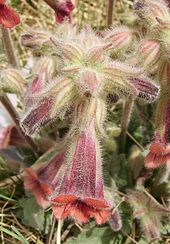| Rehmannia | |
|---|---|

| |
| Flowers of Rehmannia glutinosa | |
| Scientific classification | |
| Kingdom: | Plantae |
| Clade: | Tracheophytes |
| Clade: | Angiosperms |
| Clade: | Eudicots |
| Clade: | Asterids |
| Order: | Lamiales |
| Family: | Orobanchaceae |
| Tribe: | Rehmannieae Rouy 1909 [1] |
| Genus: | Rehmannia Libosch. ex Fisch. & C.A. Mey. |
| Species | |
Rehmannia is a genus of seven species of flowering plants in the order Lamiales and family Orobanchaceae, endemic to China.[2] It has been placed as the only member of the monotypic tribe Rehmannieae,[1][3] but molecular phylogenetic studies suggest that it forms a clade with Triaenophora.[4] Contrary to the immense majority of the taxa of Orobanchaceae, Rehmannia is not parasitic.
Systematics[edit]
Etymology[edit]
Rehmannia is named for Joseph Rehmann (1788–1831), a physician in St. Petersburg.[5]
Homonymy[edit]
The name "Rehmannia" has also been given to a genus of Jurassic ammonites of the family Reineckeidae.
Classification[edit]
The genus was included in the family Scrophulariaceae or Gesneriaceae in some older classifications. The current placement of the genus is in neither Scrophulariaceae s.s. nor Plantaginaceae s.l. (to which many other former Scrophulariaceae have been transferred). Earlier molecular studies suggested that its closest relatives were the genera Lancea and Mazus,[6] which have been included in Phrymaceae.[7] Subsequently, it was found that Rehmannia groups with Triaenophora, and both taxa are jointly the sister group to Lindenbergia and the parasitic Orobanchaceae.[8] A 2016 classification of flowering plants, the APG IV system enlarged Orobanchaceae to include Rehmannia,[9] making it one of the few genera in the family, along with Lindenbergia, not to be parasitic.
Species list[edit]
As of March 2022[update], Plants of the World Online accepted six species:[10]
- Rehmannia chingii H.L.Li
- Rehmannia chrysantha M.H.Li & C.H.Zhang
- Rehmannia glutinosa (Gaertn.) DC.
- Rehmannia henryi N.E.Br.
- Rehmannia japonica (Thunb.) Makino
- Rehmannia piasezkii Maxim.
- Rehmannia solanifolia P.C.Tsoong & T.L.Chin
Uses[edit]
Sometimes known as Chinese foxglove due to its superficial resemblance to the genus Digitalis, the species of Rehmannia are perennial herbs. The plants have large flowers and are grown as ornamental garden plants in Europe and North America, and are used medicinally in Asia.
Traditional Chinese medicine[edit]
Known as dìhuáng (地黄) or gān dìhuáng (干地黄) in Chinese, R. glutinosa is used as a medicinal herb for many conditions within Chinese traditional formulations.[11]
It is the main ingredient in a mixture called si wu tang (four substance decoction) along with Dang gui, Chinese peony (bai shao yao), and Ligusticum striatum (chuan xiong) that is considered a fundamental medicine to support making blood.[12]
When two ingredients, peach (tao ren) and safflower (hong hua), are added, it is called tao hong si wu tang (four substance decoction with peach pit and safflower), which is used in TCM for fatigue.[12]
Chemical constituents[edit]
Rehmannia contains the vitamins A, B, C, and D,[citation needed] as well as other compounds, such as catalpol, an iridoid glycoside.
References[edit]
- ^ a b Rouy, G. (1909). "Conspectus des tribus et des genres de la famille des Scrofulariacées". Rev. Gen. Bot. 21: 194–207.
- ^ "Rehmannia in Flora of China @ efloras.org". www.efloras.org. Retrieved 2020-05-10.
- ^ Kadereit, Joachim W. (2012-12-06). Flowering Plants · Dicotyledons: Lamiales (except Acanthaceae including Avicenniaceae). Springer Science & Business Media. p. 426. ISBN 978-3-642-18617-2.
- ^ Li, Xi; Feng, Tao; Randle, Chris & Schneeweiss, Gerald M. (2019). "Phylogenetic Relationships in Orobanchaceae Inferred From Low-Copy Nuclear Genes: Consolidation of Major Clades and Identification of a Novel Position of the Non-photosynthetic Orobanche Clade Sister to All Other Parasitic Orobanchaceae". Frontiers in Plant Science. 10: 902. doi:10.3389/fpls.2019.00902. PMC 6646720. PMID 31379896.
- ^ Gledhill, David (2008). "The Names of Plants". Cambridge University Press. ISBN 9780521866453 (hardback), ISBN 9780521685535 (paperback). pp 328
- ^ Oxelman, Bengt; Kornhall, Per; Olmstead, Richard G.; Bremer, Birgitta (2005). "Further disintegration of Scrophulariaceae". Taxon. 54 (2): 411–425. doi:10.2307/25065369. ISSN 1996-8175. JSTOR 25065369.
- ^ Beardsley, Paul M.; Olmstead, Richard G. (2002). "Redefining Phrymaceae: the placement of Mimulus, tribe Mimuleae, and Phryma". American Journal of Botany. 89 (7): 1093–1102. doi:10.3732/ajb.89.7.1093. ISSN 1537-2197. PMID 21665709.
- ^ Xia, Zhi; Wang, Yin-Zheng; Smith, James F. (2009). "Familial placement and relations of Rehmannia and Triaenophora (Scrophulariaceae s.l.) inferred from five gene regions". American Journal of Botany. 96 (2): 519–530. doi:10.3732/ajb.0800195. ISSN 1537-2197. PMID 21628207.
- ^ The Angiosperm Phylogeny Group (January 2016). "An update of the Angiosperm Phylogeny Group classification for the orders and families of flowering plants: APG IV". Botanical Journal of the Linnean Society. 181: 1–20. doi:10.1111/boj.12385.
- ^ "Rehmannia Libosch. ex Fisch. & C.A.Mey.". Plants of the World Online. Royal Botanic Gardens, Kew. Retrieved 2022-03-21.
- ^ Jim English (2010). "Traditional Chinese Herbs for Arthritis". Nutrition Review. 5 (2). Archived from the original on 2011-12-10. Retrieved 2011-12-29.
- ^ a b Liu, Chongyun; Tseng, Angela; Yang, Sue (2004). Chinese Herbal Medicine: Modern Applications of Traditional Formulas. CRC Press. pp. 174–175. ISBN 9780203493892.